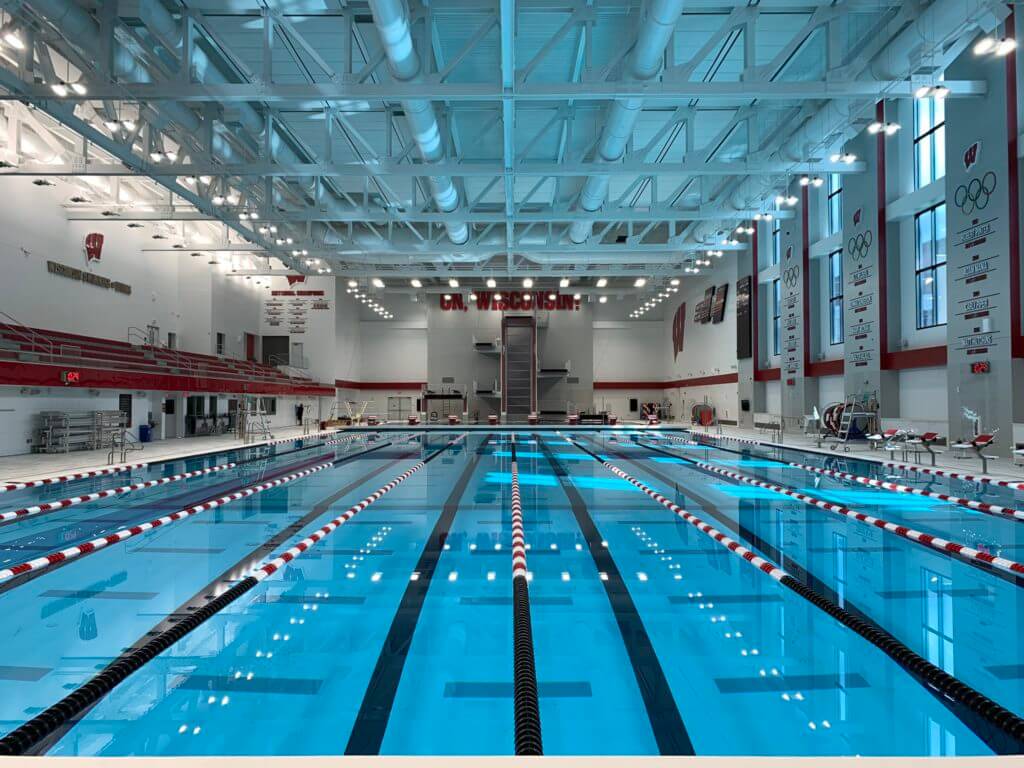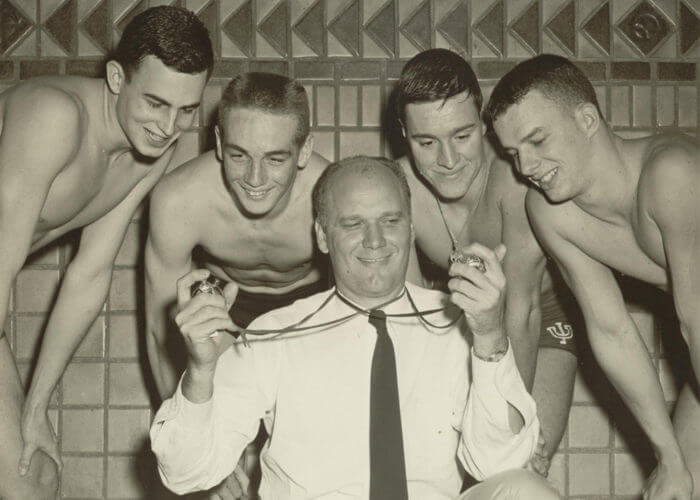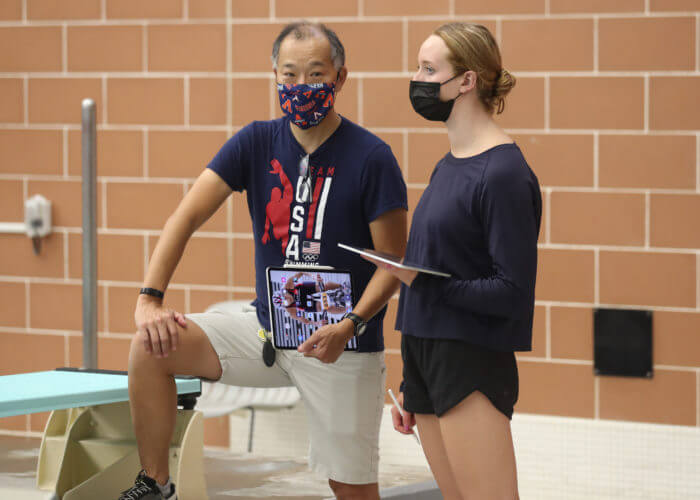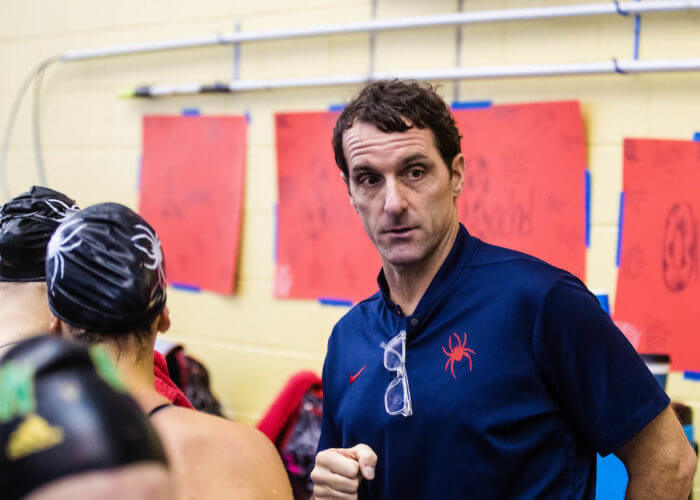A Discussion On Swim Training: Is It An Art or Science?

A Discussion On Swim Training: Is It An Art or Science?
Like the rest of life, the answer to the above question is complicated. Dudley Duncan’s recent The Art of Swimming is just the latest piece of aquatic literature to label swim coaching as “art.” “After how many years, it’s still art in people’s minds,” says Rod Havriluk, president of Swimming Technology Research and a lifelong swimming sport scientist and former coach.
“No mention of science whatsoever. It’s very disappointing. We haven’t gotten any further than that. I am hard pressed to name many coaches who would speak to science. The people I know who are promoting science in swimming are scientists,” he says.
The 1960s produced two hall of fame coaches who linked swimming technique elements to scientific principles. In his 1963 book Forbes Carlile on Swimming the Australian coach discussed the four competitive strokes in depth. He ultimately concluded that coaching technique is “more art than science” citing the lack of hard and fast scientific principles to guide us.”
James E. (Doc) Counsilman’s The Science of Swimming took a different approach. When published in 1968, his 450+ page tome was, and is still recognized, as a seminal document devoted to the principles of exercise science and biomechanics as applied to swimming.
“In contrast to Carlile, Counsilman applied many ‘hard and fast scientific principles’ to improve technique,” says Havriluk. The book’s first chapter on “mechanical principles” addresses buoyancy, Newton’s Law of Action-Reaction, the relationship of resistance and velocity, conservation of angular momentum and the transfer of momentum. “Each of these principles can be used to determine the most effective elements of swimming technique,” notes Havriluk.
From Counsilman’s coaching success and enduring interest in swimming and science came the creation of the Counsilman Center for the Science of Swimming, a research institute within Indiana University’s School of Public Health. There, researchers like Joel Stager, the late Dave Tanner and Jan Prins continued to advance the understanding of aquatic development much of which was funneled into the Journal of Swimming Research which has now evolved into American Swimming which is published by the American Swimming Coaches Association.
 From 1974 -1978, Prins was Counsilman’s head assistant coach. These days he is an associate professor with the Department of Kinesiology and director of the Aquatic Research Laboratory at the University of Hawaii-Manoa (where he was also head coach for 10 years). He is also founder and director of Swimming Biomechanics Inc. For the past 18 years he has been involved with unique swimming research, using multiple high-speed video cameras and motion-capture software to analyze the stroke mechanics of elite swimmers.
From 1974 -1978, Prins was Counsilman’s head assistant coach. These days he is an associate professor with the Department of Kinesiology and director of the Aquatic Research Laboratory at the University of Hawaii-Manoa (where he was also head coach for 10 years). He is also founder and director of Swimming Biomechanics Inc. For the past 18 years he has been involved with unique swimming research, using multiple high-speed video cameras and motion-capture software to analyze the stroke mechanics of elite swimmers.
One Scientist’s View
“I would categorize coaches as ‘applied scientists,’ says Prins, “… applying the principles of the exercise sciences … physiology in designing workouts based on metabolic responses (lactate profiles, etc.) and … biomechanics, finding the resources to film and analyzing underwater stroke mechanics.
“We should not forget the sport psychologists, but in all honesty, my take is that to be a successful coach you need to have an innate feel for this part of the equation. We know great coaches who can be seen as world-class psychologists but ran for cover the moment anything remotely connected to science was brought up!!”
Artists or scientists? “It would be hard to make any separation,” Prins says. “Limiting the question to successful coaches at all levels, let’s put them into two groups. The first are those who actively involve themselves with the sciences. They read, consult and above all are not reluctant to try new ideas based on sound scientific evidence. Just as importantly, they are astute enough to know when something isn’t working and are not embarrassed or reluctant to change. Doc certainly combined all these disciplines, but I can tell you first hand, he was the first to dump anything that did not work after trying it for a reasonable time!
“The second group are the shrewd followers. They are less apt to spend too much time studying the sciences, but more than able to successfully take the first group’s ideas and apply them seamlessly to their teams. This group, however, runs the risk of perhaps being too quick to follow any and all ideas.
Progress
The good news is that Prins believes science has changed the way coaches approach swim training today. “When I see the way current workouts are tailored, paying attention to aerobic and anaerobic responses, short- and long-term, there’s no question that advances in exercise physiology have made a major impact on the effective training.
“The same can be said regarding swimming biomechanics. An important example is the current emphasis on propulsive drag forces … directing the hands earlier towards the feet in the Freestyle, Backstroke and Butterfly. Although this trend has taken time to evolve and stems more by observing what the talented swimmers are doing underwater, this shows very real progress,” he says.
So, are coaches more open to what science tells us? “I believe most are … however, and I don’t fault most coaches, but there is an unfortunate tendency to mistake pronouncements made by some parts of the coaching profession as always scientifically sound. While it may be easy to follow these suggestions, especially if the source is a successful active or former coach, these recommendations need to stand up to sound analyses. That is one reason we started the Journal of Swimming Research in the early 80’s,” he says.
Another Voice
Genadijus Sokolovas is a senior physiologist for Global Sport Technology. For eight years he worked with USA Swimming (think Michael Phelps, Dara Torres, et. al) and for decades toured the world as a sport scientist and expert on how biomechanics improve human performance in the water.
He, too, believes that “sport science and art in swimming has changed in the last decades. Fifty years ago, there was very little science in swimming,” he says. “Coaches taught kids swimming technique using the same methods as they had been taught. High volume training was the main way to improve performances. This approach worked at that time; results continued to improve. However, studies showed us that there are more optimal ways to improve performances using new knowledge from biomechanics, training, recovery, nutrition, strength training, etc. Our studies helped us to understand that swimmers can swim much faster than current world records. That’s why swimming world records will continue to improve.

Photo Courtesy:
“Fast swimmers are usually fast because they are really strong, really well conditioned and doing some things really well, but there are no fast swimmers doing everything really well,” says Havriluk. Mark Schubert was the poster coach for mega-yardage. His teams at Mission (Viejo and Bay) won 44 national club titles, gobs of international medals and were nothing if not well conditioned.
In addition to offering volume Schubert experimented with lactate testing, blood testing and even painful muscle biopsy procedures. “We did this to basically test stress, measure effort, identify medical issues, pinpoint event selection and develop athlete histories.” he says. “In the 80’s we worked with Michael Lohberg. A favorite test set was 5 x 200 with lactate testing done after each 200.”
When he was doing his testing at Mission Viejo, Schubert had access to expertise and resources that helped mitigate expense. Not every coach is so lucky. Lactate testing became passe because, says Havriluk, “I don’t think the payoff was great enough. Most coaches aren’t going to spend the time doing that. The benefit is that they would see the status of their swimmers at the time. Now, how helpful that is questionable. Other options are to check time or heart rate. It’s nice to have that information, but I don’t think many coaches will take the time or the expense. And that’s the problem with so many scientific concepts. They take time and money.”
Last year Schubert spent six months in China working with 2x Olympic gold medalist Ye Shiwen. “We did a lot of lactate testing, especially at the end of sets so she could see where she was and how she compared with previous efforts. Going forward to Paris I will have a pro and college group where we will do a lot of lactate testing. Even more we will be working with nutritionists — which I consider dealing with science. That’s probably an area into which coaches don’t delve much and most athletes ignore. These days there are a lot more pros dealing with nutritionists because it’s their livelihood,” Schubert says.
Art or science? “A very good question says Schubert. “If I had the means I’d say 50-50. I don’t always have the means, but the other 50 percent is basically experience, writing practices, knowing your athletes, their motivation, how to push their buttons in practice and competition. I am not discounting the scientific aspect, obviously a coach has to have a pretty good knowledge of science.
Wah Hoo Wah
One team utilizing science and art/coaching expertise in equal measure is the NCAA’s 3x national champion University of Virginia women’s team. “First, swimming is not one size fits all,” says associate head coach Tyler Fenwick. “Last season we had NCAA scorers in the 200 backstroke from three different training groups. When UVA swimmers arrive as freshmen, we assess their training background, previous volumes and training styles to identify training plans that will work best for them.
“Athletes do not go strictly with the same coach or training group daily,” says Fenwick. “We have 55 swimmers and close to 45 different training plans. We consider physiology, psychology, specific needs and then move athletes from coach to coach and group to group daily based on their unique plans. This allows them to get exactly what they need when they need it.
“Analytics is another use of sports science in our program. We utilize Tritonwear to measure distance per stroke, stroke rate, record splits, etc. This data allows coaches and athletes to compare, contrast and analyze performance in real time. Efficiency (i.e. Kate Douglass’ stroke count in her 200 breaststroke) is one of our cornerstones. Tritonwear provides a consistent reference point and feedback that allows our coaches and swimmers to help improve efficiency in the way we attack a race.

Dr. Ken Ono with Paige Madden; Photo Courtesy: Matthew Kent Riley/University of Virginia
“Dr. Ken Ono is a world-renowned mathematician who developed a system that integrates the use of body sensors, underwater video, special algorithms and analytics to help our team find areas of opportunity in races. During testing, Dr. Ono and his assistants hook sensors up to our swimmers. These are linked to iPads and capture propulsion metrics once the subject begins to swim. Tests are typically run at a race pace, allowing Dr. Ono to analyze speed within strokes, turns and off the walls. He then compares race data to identify where swimmers are losing ground to competitors. The resulting charts, graphs and photos illustrate opportunities for improvement. We do race analysis at major selection meets, particularly between prelims, semi-finals and finals looking to maximize performance,” says Fenwick.
The Greening of Megan Oesting
Head coach of Bend Swim Club, member ASCA board of directors, former national team member, CSCAA All-American, national age group coach of the year Megan Oesting has observed a shift in training tools available for developing athletes. “The change is that we now have two ways, quantitative and qualitative, to observe our athletes. Time was we only had qualitative data to rely on from a process standpoint. The clock would give us quantitative feedback at the very end of the process, but now we can check for quantified progress throughout the process, which is quite powerful,” she says.
“Having access to quantitative data every day has allowed me to be a better observer of my athletes and of my own program; it’s allowed me to learn more about my own system of coaching in a faster and deeper way. I’ve improved more as a coach since I started using Tritonwear than I have in the 25 years before that combined.”
As for others, Oesting opines “I’m not sure coaches are as open to seeing quantitative data as they should be. Sometimes I feel like coaches are threatened by data driven feedback because it shows us where we could be better. Accountability is hard to swallow sometimes. But as we tell our athletes, we’ve got to be open to feedback and take a hard look at what we’re doing in order make the changes that will make us actually better.
“The reality is that coaches are often overworked and pulled in so many directions that taking on the project of expansion to learn how to include data in your program can be a tall order. Coaches with curiosity and capacity will move into it and be deeply rewarded for their efforts,” she says.
Wearables
Matt Barany is in his 18th year as women’s coach at The University of Richmond. Seven years ago he was introduced to the wearable technology and interested in seeing what it told him about heart rate variability (HRV). What he found was way more than he bargained for. For one, it provided a whole new perspective on strain, how to alter lifestyle behaviors, improve sleep and general athlete physical and mental well-being. “We root many team decisions now in the info we’ve gleaned,” he says.
 Barany’s Spiders have continued to perform well at the Atlantic 10 championships and he credits much of the success to the program’s focus on optimal health and recovery. Team sleep duration has increased by 85 minutes per person per night since 2016 and team GPA is up (.84) during same period.
Barany’s Spiders have continued to perform well at the Atlantic 10 championships and he credits much of the success to the program’s focus on optimal health and recovery. Team sleep duration has increased by 85 minutes per person per night since 2016 and team GPA is up (.84) during same period.
A member of the NCAA’s Competitive Safeguards and Medical Aspects and the Division I Men’s and Women’s Swimming and Diving Committee, Barany has become a big proponent of what science can reveal about athlete behavior. “Ultimately as we get embedded with more science the art comes with the relationships and with a heavy lean on mental health because there is neuroscience for mental health. As we turn more to technology and computers I think the actual art of coaching is more in the soft skills. The true art of coaching right now is the soft skills around mental health, care and kindness. No wearable does that.
“Some of the coaches leaving the sport right now aren’t prioritizing mental health. As a young coach you can engage in all the most progressive technology, but if you aren’t looking out for the mental health of your student-athletes your career is going to be very short,” he says. “I can make an argument that there is technology out there for mental health because a decline in HRV can be reflective of some mental health crises, especially depression and anxiety but nobody’s using that to diagnose.
“It goes back to having relationships. We can have all the gadgetry we want, but if you don’t have healthy relationships you aren’t going to get the result you want. As coaches leave the sport it is going to be interesting to see what careers are going to look like and how much data and technology are integrated into a program. The biggest trigger for mental health problems is cell phones and media. There is not a report you can find that says social media is good for you. That’s the battle coaches face these days,” he says.
Back to the Future
In 1968, Counsilman predicted someone would swim a 100 meter free in 40 seconds. So far, not yet. The consensus is that times will keep getting faster and conventional training methods will lead to improvement, but not to the 40 second threshold. “Science is not necessary to break 46 seconds,” says Havriluk. “Experience is sufficient. Applying science, however, is likely the only way to break 40 seconds.”
**************************
Some Swimming Science Resources
Many coaches use technologies to improve swimming performances: underwater video, wearable devices, software for training design, tests using scientific equipment (Swim Power, accelerometers, tensiometers, lactate meters, smart goggles, etc.).
Global Sport Technology identifies strengths and weaknesses in swimming technique using Swim Power technology. Once identified coaches can modify individual swim training, implement a scientifically based Learn-To-Swim programs, select optimal training volumes using E-Coach, Talent ID and Development programs to predict swimmer performance in long-term and short-term training. www.globsport.com
Freestyle Biomechanics. Terrific, series of state of the art, video-on-demand programing illustrating proper stroke mechanics. Each section includes common mistakes taken from actual swimmers. Incorporates the use of high-speed videography and motion analysis software to generate reports which display a detailed analysis of key portions of stroke mechanics. www.freestylebiomechanics.com
Tritonwear. An artificial intelligence-based comprehensive swim analytics platform that tracks 13 different metrics based on swimmer motion. The metrics include splits, stroke rates, index and speed, DPS, time in breakouts, turns and underwater. Tritonwear.com.




Great article, but you forgot one of the most important coach/scientists in Charles “Red” Silvia from Springfield College.